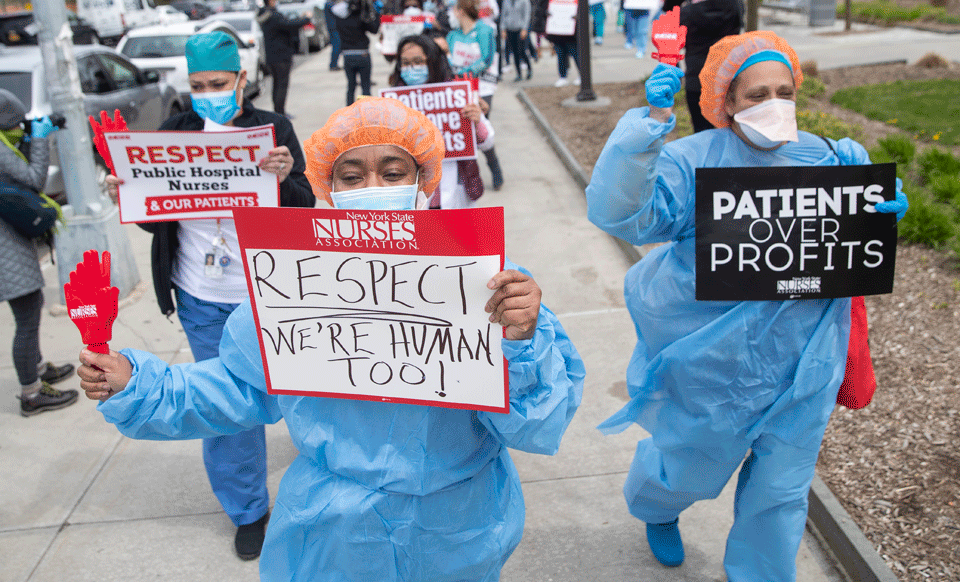
In September 1945, a little-remembered frenzy erupted in the United States. Japan had surrendered, ending World War II, but American meat packers, steelworkers, telephone installers, telegraph operators, and auto assemblers had something different from partying in mind. In rolling actions, they went on strike. After years of patriotic silence on the home front, these workers, along with unhappy roughnecks, lumberjacks, railroad engineers, and elevator operators—some 6 million workers in all—shut down their industries and some entire cities. Mainly, they were seeking higher pay—and they got it, averaging 18% increases.
The era of raucous labor is long past, and worker chutzpah along with it. That is, it was—until now. Desperately needed to staff the basic economy while the rest of us remain secluded from COVID-19, ordinarily little-noticed workers are wielding unusual leverage. Across the country, cashiers, truckers, nurses, burger flippers, stock replenishers, meat plant workers, and warehouse hands are suddenly seen as heroic, and they are successfully protesting. For the previous generation of labor, the goal post was the 40-hour week. New labor’s immediate aims are much more prosaic: a sensible face mask, a bottle of sanitizer, and some sick days.
The question is what happens next. Are we watching a startling but fleeting moment for newly muscular labor? Or, once the coronavirus is beaten, do companies face a future of vocal workers aiming to rebuild lost decades of wage increases and regained influence in boardrooms and the halls of power?

For now, at least, some of the country’s most powerful CEOs are clearly nervous. Late last month, Apple, faced with reporters asking about a company decision to furlough hundreds of contract workers without pay, did a quick about-face. Those employees, Apple now said, would receive their hourly wages. A few weeks earlier, after Amazon warehouse workers demanded better benefits during the virus pandemic, that company also reversed course, offering paid sick days and unlimited unpaid time off.
The backdrop is a country at a standstill and uncertain over which businesses will survive the current economic shakeout, and in what form. With some notable exceptions, very few companies seem prepared to risk riling their employees, especially given broad popular support for workers at their grocery stores, nurses at their hospitals, and drivers who are keeping supply arteries open.
The past four decades have been perhaps labor’s weakest since the Industrial Age.
But if companies are responding to those who are protesting, they might also think ahead and preempt festering trouble down the road. “I like to believe people will say, ‘We treat these people as disposable, but they are pretty indispensable. Maybe we should do what we can to recognize their contribution,’” says David Autor, a labor economist at MIT and co-director of the school’s Work of the Future Task Force.
Until the 1980s, layoffs were barely a thing, writes Louis Uchitelle in The Disposable American: Layoffs and Their Consequences. Companies tended to avoid large-scale dismissals because they violated a red line of publicly accepted practice and also could finger the company for blame. The United States was still in the age of company as community and societal patron, and even when workers went on strike, they were generally not replaced, because the optics would be bad.
But in 1981, President Ronald Reagan changed all that. Some 12,000 air traffic controllers went on strike, demanding higher pay and a shorter workweek. In a breathtaking decision, Reagan fired all but a few hundred of them. The Federal Labor Relations Authority decertified the controllers’ union entirely. The era of strong labor was over.
In the subsequent age of the no-excuses layoff, the number of major strikes has plunged. Starting in 1947, when the government began keeping such data, there were almost always anywhere from 200 to more than 400 big strikes every year. But in 1982, the year after the air traffic controllers debacle, the number for the first time fell below 100. In 2017, there were just seven. “There was damage to self-esteem every time there was a layoff. It took the militancy out of organized labor, and I don’t think it ever recovered,” Uchitelle says.
The past four decades have been perhaps labor’s weakest since the Industrial Age. For a half century, those working for hourly wages have won almost no real gains. The real average hourly wage in 2018 dollars adjusted for inflation was $22.65 in 2018, compared with $20.27 in 1964—just an 11.7% gain, according to Pew Research. Real median hourly wages rose by only another 0.6% last year despite the sharp tightening of the job market and an increase in the minimum wage across the country, according to the Bureau of Labor Statistics.
The current revival of worker activism precedes COVID-19 in the unlikeliest of places. In 2018, West Virginia teachers, among the lowest paid in the nation and four years without a raise, went on strike for nine days in a demand for higher pay. That they won a 5% increase was one astonishing thing. But the walkout itself was stunning, specifically because of the state where it occurred—a former bedrock of ultra-militant coal miners who had repeatedly gone to actual war for better pay and safety but more recently were a bastion of worker passivity.
If teachers are an indicator of what is coming, Amazon, fast food restaurants, hospitals, and gig companies have a long, hot few years ahead.
Last year, the West Virginia teachers were on the picket lines again. This time, they stopped the state legislature from funding private schools in what they saw as an attempt to weaken their newly revived strength. Officials buckled after just a day. The strikes meanwhile spread to a dozen red and blue cities and states. Often wearing red shirts as the symbol of the strikes, the teachers were demanding more money—from 2000 to 2017, teachers’ real salaries actually shrunk by 1.6% nationally, according to the National Center for Health Statistics—as well as more supplies and help in the classroom. In Arizona, teachers won a 20% raise, and Los Angeles teachers won a 6% raise. That triggered more strikes through much of 2019, with Chicago teachers, for one, winning a 16% pay raise. Strikes seemed likely this year, too, in Detroit and Philadelphia, for starters.
If teachers are an indicator of what is coming, Amazon, fast food restaurants, hospitals, and gig companies have a long, hot few years ahead. On April 6 alone, the employees of a Los Angeles McDonald’s walked out when a co-worker was diagnosed positive for the coronavirus. For the second time in a month, workers at a Staten Island Amazon warehouse went on strike after 26 co-workers came down with the virus. And outside Chicago, employees of two plants walked out because management failed to immediately announce that co-workers had been diagnosed with COVID-19.
Across the country, workers are on the march over safety, pay, and sick days. The picture is jarring at a time when 16 million people are newly out of work. Companies and CEOs need to prepare for a new post-COVID-19 reality where workers will recognize their power — and use it.

Tragic stories are part of what is giving new labor its resonance, like that of Leilani Jordan, a 27-year-old grocery clerk with cerebral palsy in Largo, Maryland, who kept working despite feeling sick because she felt needed during the crisis and died last week. (Her final paycheck: $20.64.) And of postal workers across the country who keep sorting, transporting, and delivering the mail and packages to every one of our homes, with a toll so far of 12 dead, 600 confirmed with the virus, another 6,000 under quarantine—and very little apparent hope of a government bailout.
Workers are galvanizing and telling their stories through social media, rarely requiring the organizational meticulousness that made Old Labor so formidable. How companies respond to and get in front of, such post-union employees will largely cement their reputation after COVID-19 passes.
When public relations firm Edelman recently surveyed public opinion in 12 countries on what companies should do in the age of the coronavirus, 89% responded: “protect your employees.” If you can get ahead of worker activism and look after your employees now, says CEO Richard Edelman, the public will begin on your side.
When the virus struck Hilton Hotels starting in January, its global occupancy plummeted to somewhere between 10% and 15%, and most of its 6,100 managed and franchised properties closed. Executives were convinced that the travel industry would eventually rebound, but from there they faced a conundrum: They did not want to lose a trained workforce, but they also knew they and their franchisees could not afford to keep their approximately 260,000 employees on the payroll. So, on March 24, the decision was announced to, in effect, loan them out.
Staff in Hilton’s human relations unit contacted counterparts at Amazon, Albertson’s, CVS, and Walgreens, says Nigel Glennie, vice president of corporate communications at Hilton. These retailers were experiencing COVID-19 boomlets and, combined, were in the market for hundreds of thousands of workers. Were they interested in some already trained workers, Hilton asked, who are expert specifically in catering to exceedingly particular customers? So an expedited hiring portal was set up, ultimately connecting Hilton’s workforce with 28 retailers that were suddenly responsible for almost the entire working economy.
The outcome was ideal for Hilton: It would not lay off but instead furlough its workers, thus allowing them to collect unemployment checks or work elsewhere. Once the crisis ended, they could return to Hilton. “We have a commercial interest in this decision. We know we have well-trained people who we want back,” Glennie says. “We wanted to make sure they were looked after. We want to do the right thing by our people.”
Jeff Lackey, vice president of talent acquisition for CVS Health, says his company was seeking 50,000 new employees at the time. Albertson’s says it was hiring 30,000. Neither knows exactly how many of Hilton’s workforce are now working for their respective companies, but Lackey says the hiring process was being completed in as little as a single day. “I understand what it’s like to live paycheck to paycheck,” he says.
Less flattering attention has gone to companies that have violated an unwritten set of rules that have emerged for corporate behavior. Hospital management has been upbraided for suspending nurses who try to protect themselves by buying their own equipment and disciplining those who speak out. Former employees of Bird, the scooter company, described drawn-out hours of uninformed dread prior to an announced Zoom meeting, followed by a short announcement by someone they did not know. And Dig Inn, the fast-casual chain, sprung the news by text.
Sephora, too, has been faulted publicly by recently laid-off employees. At first, the retail beauty chain closed but promised to keep paying everyone for as long as the stores remained shuttered. Then, on March 31, it laid off part-time staff anyway. The decision caught a lot of Sephora employees by surprise. In tweets and online videos, some workers said they had been on calls with their managers that very day discussing the opposite—how they would go ahead in the new environment. Suddenly, though, employees received texts saying that in 15 minutes, they were to participate in a mandatory audio call.
When Lydia Cymone, a Sephora makeup artist in Alpharetta, Georgia, heard the call, she was right in the middle of videotaping a makeup tutorial and posted the tearful video. Brittney Coorpender, who did facial treatments at a Sephora store in San Jose, California, told me in an email exchange that she felt misled. “Women/men who forgot to mute themselves could be heard sobbing right before I ended the call,” Coorpender wrote. “They promised and promised us we were fine and gave zero indication we weren’t, until that call.”
In response to a request for comment, Sephora sent the March 31 statement it posted to its website. Dan Davenport, president of recruiter Randstad RiseSmart, says, “If you’re making a statement that you’re not going to be laying anyone off, you better be right about that.”
If corporate America does face a post-COVID-19 reckoning from workers, the gig economy seems like one of the top probable targets. Jim Chanos, president of Kynikos Associates, a hedge fund that shorts stocks, was made famous in the early 1990s for blowing the whistle on Enron. Today, Chanos is shorting Uber and Grubhub, among other gig companies. In an interview, he said he had already been shorting the two companies but has added to these bets since the virus struck.
What makes them weak, in Chanos’ view, is the optics of their business model, which is based on paying an arguably miserly cut of revenue to their workers and a refusal to make them actual employees. While allowing these companies to avoid a lot of the conventional costs of doing business, the strategy has also always left the gig companies at risk of their workers and the public turning against them. Chanos predicts that’s exactly what’s going to happen in the post-coronavirus era. The public is “going to look askance” at companies that have relied on taxpayers to fully cover their workers’ jobless benefits since they do not pay into unemployment insurance funds. “Business models based on ridiculous labor rates plus arbitrage where you foist all your costs onto the employee are coming to an end,” he says.
Until the virus, the notion of unionized tech workers was just that—a notion that seemed to violate the very spirit of Silicon Valley. It’s still hard to imagine unionized software engineers. But it’s equally difficult to say where the boundaries of the possible lie.
White-collar tech activism goes back two years when Google workers around the world walked off the job in a protest against sexual harassment. More workers are griping now. Last month, some Instacart workers walked off the job in a bid for a higher share of the revenue and better safety; in some cities, they are starting to join unions like the United Food and Commercial Workers local in Chicago. In San Francisco, Uber and Lyft drivers protested last month in front of Uber headquarters.
The tremors, though, will be felt not just in the gig economy but also tech at large: In February, employees at Kickstarter, the crowdfunding platform, voted to unionize, becoming the first white-collar tech company staff to do so, according to a database at Cal Berkeley. The Teamsters are making an open run at organizing other Silicon Valley workers. If you put COVID-19 out of your mind, the move is mind-blowing. Until the virus, the notion of unionized tech workers was just that—a notion that seemed to violate the very spirit of Silicon Valley. It’s still hard to imagine unionized software engineers. But it’s equally difficult to say where the boundaries of the possible lie.
The biggest fish of all in terms of tech unionization is Amazon. The e-commerce giant is beset with worker complaints just as it has begun to transcend its barbarian image, repositioning itself as a public good at the very center of the U.S. economy. An issue that has drawn particular heat is its decision on March 30 to fire Chris Smalls, a worker at an Amazon warehouse on Staten Island who loudly complained about health safety. On April 8, a group of Democratic U.S. senators wrote a letter to Amazon CEO Jeff Bezos raising skeptical questions about Smalls’ dismissal and COVID-19 safety generally at company warehouses.
Amazon has seemed generally conflicted: On one hand, it has responded with added pay and off-days for sick employees. But Amazon has also repeatedly fired workers it has deemed disloyal—three employees just over the past week who had criticized health conditions. Whole Foods, too, owned by Amazon and run by John Mackey, the devotee of “conscious capitalism,” faced a sick-out in March. In a statement, an Amazon spokesperson said the points raised in the senators’ letter were unfounded and that Smalls was dismissed for violations of social distancing guidelines. “Nothing is more important than the safety of our teams,” the spokesperson said.
Robert Shiller, the Nobel Prize–winning economist at Yale, compares labor’s newfound position to its stature in the Great Depression, when workers also suddenly were conferred with vast public sympathy.
While complaints and denunciation of Amazon abound, no one has gone so far as to try an old-style shutdown of any of the company’s operations—the kind of display of strength that typified unions in their heyday. For that matter, no rabble-rousing worker is known to have recently banged on the desk of a major company executive—or a leading politician—and demanded the production of a plant be kept open and workers on the job. Even if one did, would the public go along? Would large numbers of people stop shopping at Amazon? If they did, Amazon would have to concede quickly, just as railroad workers shut down transportation across the country in labor’s peak. “If you could really shut down a warehouse, that would really shock Amazon and get them to address the worker concerns,” says Steven Greenhouse, author of Beaten Down, Worked Up, a history of American labor.

Robert Shiller, the Nobel Prize-winning economist at Yale, compares labor’s newfound position to its stature in the Great Depression when workers also suddenly were conferred with vast public sympathy. “The narrative was that it wasn’t their fault. There was something in the system,” Shiller told me. “This is another case where obviously it’s not their fault. And there is heroism in how they are delivering to us through this.”
In a way, labor’s resurgence is not all that surprising. The age of Trump and Brexit is, at its crux, an uprising against globalization, the movement that, after Reagan and his contemporaneous British counterpart, Margaret Thatcher, diminished labor and championed worldly capitalism at whatever the local cost. If we are spurning globalization, it stands to reason that the local comes back into focus. And what is more local than the grocery bagger, the postman, the nurse?
Where workers have an advantage today has been in keeping their demands modest, drawing the public to their side, and making it very difficult for management to refuse. Worker efforts could be blunted by high unemployment, at least until jobs return. But their pluck, beaten out of them by the years of layoffs, has returned with COVID-19.
This article originally appeared at Marker under the headline. It is re-published here with permission.










